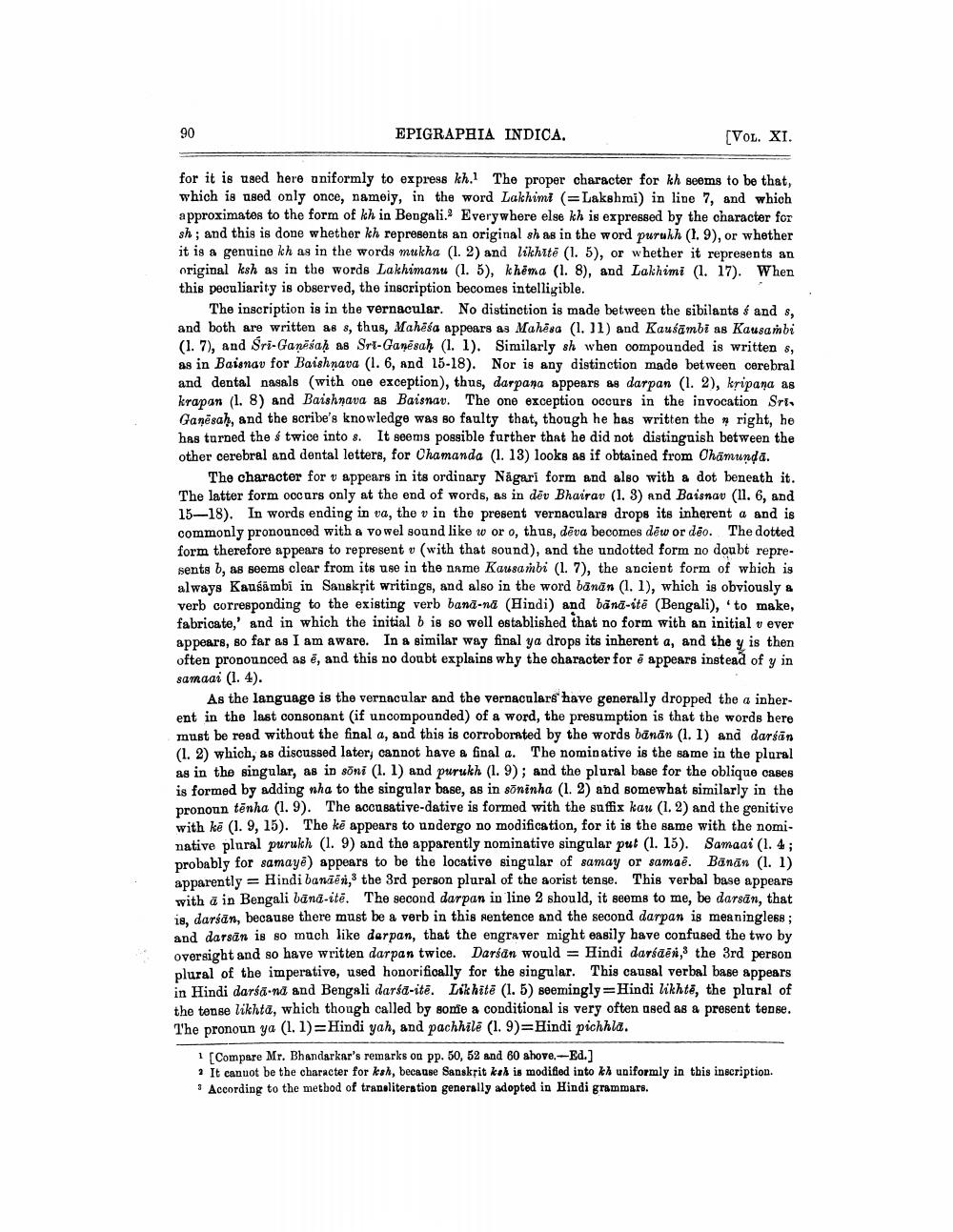________________
EPIGRAPHIA INDICA.
(VOL. XI.
for it is used here oniformly to express kh. The proper character for kh seems to be that, which is used only once, namoiy, in the word Lakhimi (=Lakshmi) in line 7, and which approximates to the form of kh in Bengali. Everywhere else kh is expressed by the character for sh; and this is done whether kh represents an original sh as in the word purukh (1.9), or whether it is a genuine kh as in the words mukha (1.2) and likhatē (1. 5), or whether it represents an original ksh as in the words Lakhimanu (1. 5), khēma (1. 8), and Lakhimi (1. 17). When this peculiarity is observed, the inscription becomes intelligible.
The inscription is in the vernacular. No distinction is made between the sibilants é and s, and both are written as s, thus, Mahēša appears as Mahesa (1.11) and Kausāmbi as Kausambi
(1. 7), and Sri-Ganëśaḥ as Sri-Ganēsah (1.1). Similarly sh when compounded is written s, as in Baisnav for Baishnava (1. 6, and 15-18). Nor is any distinction made between cerebral and dental nasals (with one exception), thus, darpana appears as darpan (1.2), kripana as krapan (1. 8) and Baishnava as Baisnav. The one exception occurs in the invocation Sri. Ganesah, and the scribe's knowledge was so faulty that, though he has written the right, he has turned the $ twice into 8. It seems possible further that he did not distinguish between the other cerebral and dental letters, for Chamanda (1.13) looks as if obtained from Chāmunda.
The character for v appears in its ordinary Nagari form and also with a dot beneath it. The latter form occurs only at the end of words, as in dēv Bhairav (1.3) and Baisnav (11. 6, and 15-18). In words ending in va, the v in the present vernaculare drops its inherent a and is commonly pronounced with a vowel sound like w or o, thus, dēva becomes dēw or deo. The dotted form therefore appears to represent v (with that sound), and the undotted form no doubt represents b, as seems clear from its use in the name Kausa mbi (1. 7), the ancient form of which is always Kausambi in Sanskrit writings, and also in the word banān (1.1), which is obviously & verb corresponding to the existing verb bana-na (Hindi) and bānā-itë (Bengali), 'to make, fabricate,' and in which the initial b is so well established that no form with an initial v ever appears, so far as I am aware. In a similar way final ya drops its inherent a, and the y is then often pronounced as ē, and this no doubt explains why the character for é appears instead of y in samaai (1. 4).
As the language is the vernacular and the vernaculars have generally dropped the a inherent in the last consonant (if uncompounded) of a word, the presumption is that the words bere must be read without the final a, and this is corroborated by the words bānān (1.1) and darsan (1.2) which, as discussed later, cannot have a final a. The nominative is the same in the plural as in the singular, as in sõni (1.1) and purukh (1.9); and the plural base for the oblique cases is formed by adding nha to the singular base, as in sõninha (1.2) and somewhat similarly in the pronoun tēnha (1. 9). The accusative-dative is formed with the suffix kau (1.2) and the genitive with kē (1. 9, 15). The kē appears to undergo no modification, for it is the same with the nominative plural purukh (1. 9) and the apparently nominative singular put (1. 15). Samaai (1. 4; probably for samaye) appears to be the locative singular of samay or samaē. Banān (1.1) apparently = Hindi banien, the 3rd person plural of the aorist tense. This verbal base appears with a in Bengali būnd-ite. The second darpan in line 2 should, it seems to me, be darsān, that is, darsān, because there must be a verb in this sentence and the second darpan is meaningless ; and darsān is so much like darpan, that the engraver might easily have confused the two by oversight and so have written darpan twice. Darśan would = Hindi darśaen, the 3rd person plural of the imperative, used honorifically for the singular. This causal verbal base appears in Hindi darsa.nd and Bengali darsa-itë. Likhite (1.5) seemingly=Hindi likhtë, the plural of the tense likhta, which though called by some a conditional is very often ased as a present tense. The pronoun ya (1.1)=Hindi yah, and pachhile (1.9)=Hindi pichhla.
1 Compare Mr. Bhandarkar's remarks on pp. 50, 52 and 60 ahove. -Ed.]
It canuot be the character for ksh, because Sanskrit kok is modified into kā uniformly in this inscription. * According to the method of transliteration generally adopted in Hindi grammars.




